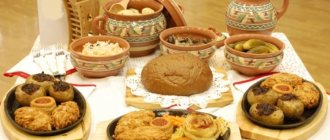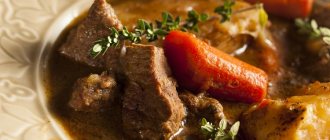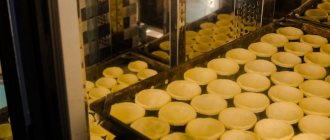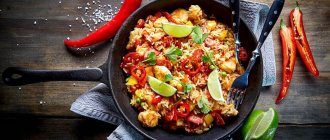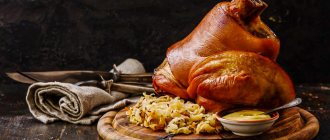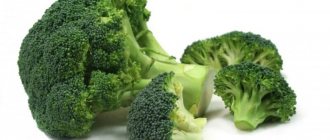A little history or how regional German cuisine was formed
The history of German cuisine dates back to the times of the Roman Empire.
Later, its formation took place in accordance with national traditions and under the influence of neighboring countries, Austria, France, which was reflected in the regional cuisine of Germany. When preparing German dishes, recipes used seasonings and technologies characteristic of neighboring regions. For example, ham is prepared differently everywhere, which is reflected in its names: Black Forest or Westphalian. Traditional German cuisine offers its own recipes in each region: in Bavaria they are proud of pies, and in Hamburg they are proud of meat and fish soups; in the south of the country you can be offered soup with snails. Moreover, the cooking recipe is unique in each case.
Modern German cuisine developed relatively recently, after the end of the Second World War. It was also formed not without the influence of its neighbors, but the main national dish of Germany remained unchanged.
What makes German cuisine different?
When highlighting the features of German cuisine, it is necessary to mention sausages and sausages, which are considered the most popular dish in Germany. Each city has its own recipe for this national pride.
In addition to sausages, minced meat dishes are popular in German cuisine. Cutlets, schnitzels, and schnellklops appear on the German table much more often than regular fried or stewed meat.
Another distinctive feature of German cuisine is the presence of spices. Moreover, they are used in moderation. German cuisine offers national dishes that are aromatic, pleasant, but not spicy.
Sausages, frankfurters, and schnitzels are served with vegetables, most often sauerkraut. Germans also use red and cauliflower cabbage, green beans, and potatoes as a side dish. The latter can serve as bread at dinner.
German cuisine and its geography
Among all other world cuisines, German cuisine can be called one of the most interesting. It is tasty and substantial, and the tradition and variety of dishes varies in different parts of the country. German cuisine includes dishes from Austria, France, and Italy.
Some native German dishes are named after a geographical location, for example, Black Forest ham, Black Forest cake, Westphalian ham, Nuremberg gingerbread, etc. In one area, daily food will consist of fatty bean soups, rye bread and pork with potatoes and beans, while in another they prefer flour and buckwheat cakes, muesli and porridge. Traditionally, Germany is considered a country that loves meat, especially pork, and potatoes. In total, there are about 1,500 types of sausages in Germany. A feature of German cuisine is the use of sauerkraut in the preparation of a variety of sausages, sausages and sausages. In addition, German cuisine has many egg dishes. Another characteristic feature of German cuisine is the widespread use of meat for preparing main courses. These are chops and schnitzel, Hamburg steak and fillet, razbraty, schnellklops, schmorbraten, etc. Minced meat is used less often. The fish is boiled or stewed. As the Germans themselves say, coffee is the “national German drink.” Official statistics show that on average each German drinks about 180 liters of coffee per year, which in terms of daily consumption is 10-12 cups per day. The only area of Germany in which tea is more popular than coffee is the East Frisian lands in the north of the country (the cities of Wilhelmshaven, Ever, Emden). A very popular dessert in Germany is such a recognized delicacy as ice cream. The structure of dishes, as well as meals, is stable throughout Germany. Cuisine of the northern part of the country On the coast of the North and Baltic seas, the main dishes, of course, are fish. It is fried, smoked, pickled in a variety of ways, and delicious soups are prepared. There are even teaser poems about people living in the north of the country: • Cod people are all stupid, They scratch their hair with a cod backbone And for skating, instead of skates, they take a couple of cod fins. • Ini, mini, mine, may, Catch the fish by the leg. If the fish is “oh-oh-oh,” Send it home. Soup of fish, meat, potatoes and pickles is a traditional dish in Northern Germany. A Hamburg specialty, eel soup takes in the flavors of the north, including whole fresh eel, onions, meat, dried apples and pears, carrots, asparagus and parsley. In Hamburg, an old recipe for a soup called Labskaus, a puree made from corned beef, pickled beets, potatoes, onions, fried eggs and pickles, has been passed down from generation to generation.
Also very popular in Hamburg is stewed beans with lard and pears, which is served in a special pot. In Bremen, as a side dish for fish, they will offer “Pinkel” - smoked sausage stuffed with white cabbage. “Pinkel” may well be an independent dish.
In Lower Saxony, a lamb dish called Heidschnukenbraten, under Rote Grütze, is served on the table.
“Rote Grütze” (translated as “Red Porridge”) is a thick traditional German assorted jam made from any red berries: currants, raspberries, strawberries, cherries, etc. It is good for tea, people bake pies with it and make desserts, mixing, for example, with cottage cheese. In bakeries and coffee shops, at train stations and metro stations you can find plastic cups with cottage cheese and Rote Grütze. In the north, bread is made from rye. It's dark, sticky, and called Pumpernickel. Saxony-Anhalt is the birthplace of one of the most unusual cakes in Europe. “Baumkuchen” (translated as “tree-pie”) is made from batter, with meringues and flavored with cardamom, cloves and vanilla. A wooden roller is dipped into the batter 13 times and rotated over an open flame, creating concentric circles reminiscent of the annual rings of a tree. Once the final layer is ready, the cake is left to cool for one day and then topped with white or chocolate frosting.
The cold climate of northern Germany does not allow for winemaking; local vodka “Schnapps” (a general name for strong alcoholic drinks made from grain and fruit, 40% strength) is usually consumed here. In December, Germans are also warmed by a ceramic cup of red wine with cloves, anise and orange peel, called “Mulled wine” or , made in Bremen.
Central Germany Central Germany is the agricultural center of the country, producing oats, potatoes, rye, and beets. Stews and potatoes abound in this area. In the Rhineland (Cologne), potato pancakes, potato salad, marinated beef and ham are especially popular. The baked goods are also very good - macaroons and delicious gingerbread. At Christmas, the streets of Cologne are filled with the aroma of Spekulatius macaroons, and in neighboring Aachen the Christmas treat is the equally fragrant Printen (gingerbread cookies made with almonds, hazelnuts, honey and spices).
In Hesse, which lies to the north, they still enjoy eating the “Green Sauce”, which Goethe highly praised. This sauce is made from no fewer than nine types of herbs and is especially good with beef and asparagus.
Delicacies in the Rhineland include marinated beef, potato salad, rye bread, potato pancakes and apple sauce. In Lübeck, be sure to try marzipan. Dresden's Christmas cakes - "Christstollen" and "Baumkuchen" - are known all over the world. When you arrive in Berlin, don’t miss the opportunity to stop by the cafe, where you will be treated to small Königsberg meatballs and delicious cakes. The famous Saxon delicacy is called “Leipziger Ahlerlei” and is a dish of vegetables and shrimp.
Thuringia is famous for its dumplings, which are recommended to be eaten with goose. In Erfurt you will be treated to delicious roasted meat "Rostbraten" in beer sauce and pancakes with onion and potato filling. In central Germany, and especially in Frankfurt, cider is produced - sparkling apple wine. Riesling is the most common grape variety in Rhineland-Palatinate. The whole world knows the wine under this name. Southern Germany Southerners are fans of pork, salads, and their version of Spätzle pasta. Many dishes, such as schnitzel and apple strudel, which are considered Bavarian, actually come from Austria. Maultaschen, giant dumplings filled with a mixture of pork, herbs and vegetables, are disguised with paste in Swabia on Good Friday so that God does not see the meat. The most vivid impression of getting to know the cuisine of Baden-Württemberg and Swabia will remain when you first try pancake soup, onion soup, and amazing smoked ham. Perhaps the most unusual dish in the entire southern region of Germany is Eintopf. This is a very thick soup, usually prepared with a large number of ingredients. The Germans themselves say that Eintopf can successfully replace an entire lunch, it is so filling.
The pride of Swabia and Baden-Württemberg is pancake soup, cabbage dishes and traditional pasta dishes (Spätzle and Schnupfnudeln). The whole world knows the smoked hams of the Black Forest, but Baden onion pies are no less appreciated. In Bavarian beer gardens, visitors are fed traditional home-cooked dishes - crispy fried pork trotters with sauerkraut, dumplings made from pretzel dough (unleavened pretzels sprinkled with salt), or fluffy dumplings made from yeast dough; fried or stuffed duck and goose. Simple, but very tasty and satisfying food. The Munich 'white' sausage with sweet mustard and Pretzels is famous. This sausage is exclusively for breakfast and has a unique light, airy texture. In Bavaria it is considered blasphemous to eat it after dinner. In Franconia you will have the opportunity to taste the best sausages - like the amazing, finger-thick Nuremberg bratwursts. Nuremberg itself is more famous for its spicy fragrant gingerbread. They are special; popular during the Christmas holidays. Bavaria is by far the most famous beer region and boasts 965 square miles of enticing green hop fields, contributing to the excellent taste and aroma of unrivaled German beer. They also have their own unique hazy beer, "Hefenweizen" (wheat beer), so named due to the abundance of wheat grown in the area.
Pilsner, a light beer, is the most popular in Germany. There are many other beer options, including the Düsseldorf Altbier, a sweet, high-alcohol Bockbier drunk at early spring celebrations; and malt “Märzen” for Oktoberfest. Among other drinks, the wines of the Main and Rhine valleys are well known, which have a rather characteristic fruity flavor. I am sure that any tourist, no matter what part of Germany he wants to visit, will enjoy the varied, but at the same time national and traditional German cuisine. And you will forever remain a fan and connoisseur of these amazing dishes!
Author: Olga Buslovskaya, Obninsk Especially for

